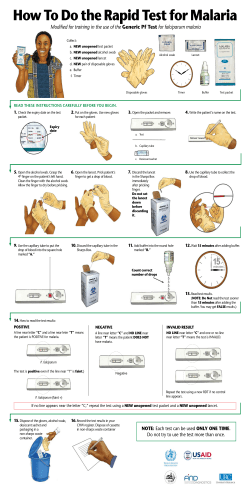
Diagnosis and Treatment Seeking Behaviours for Vivax Malaria in
Diagnosis and Treatment Seeking Behaviours for Vivax Malaria in Three Districts, Indonesia Lenny L. Ekawati1, Saharudin2, Noviyanto2, Akhmad Yuliansyah3, Josefa M. Pati4, Julianna Kaunang4, Zahlul Ikhsan5, Jeni Adijaya5, Daud Samal6, Nunung N. Mahpud1, Iqbal R.F. Elyazar1, Rita Kusriastuti7, Leily Trianty8, Sabarinah Prasetyo9 Asik Surya7, Philip Kreager9, J. Kevin Baird1,10 1 2 3 4 5 Eijkman-Oxford Clinical Research Unit, District Health Office of South Bengkulu, Provincial Health Office of Bengkulu, District Health Office of Minahasa, District Health Office of 6 7 8 9 Central Maluku, Provincial Health Office of Maluku, Indonesian National Malaria Control Program, Eijkman Institute for Molecular Biology, Centre for Health Research, Faculty of 10 11 Public Health, University of Indonesia, Institute of Human Sciences, University of Oxford, Centre for Tropical Medicine, CCVTM, University of Oxford Table 1. Demographic and socio economic characteristics of respondents BACKGROUND An improved understanding about the diagnosis and treatment of vivax malaria is essential to design more effective interventions program in Indonesia. In order to provide control programs with a “pulse of community” information, we conducted a community-based survey as regards to their knowledge, attitude and practices (KAP). The processes involved in vivax malaria diagnosis and treatment have not been assessed in Indonesia. This study aims to objectively determine community-specific treatment seeking behaviours impacting malaria. OBJECTIVES 1. Assessing malaria knowledge and perceptions regarding malaria. 2. Determining treatment-seeking behavior in managing malaria like-symptoms. 3. Assessing laboratory confirmation for malaria like-illness patients and administration of antimalarials. Figure 2. Knowledge and perceptions of malaria in communities Figure 3. Proportion of people who sought treatment for malaria- like illness Most respondents from all study sites reported that they have heard of malaria: the districts of South Bengkulu (87%), Minahasa (94%) and Central Maluku (96%). METHODS 1. Determining study areas Out of18 endemic districts with Plasmodium vivax prevalence >3%, three districts were selected to represent western, central and eastern parts of the archipelago, i.e., South Bengkulu, Minahasa and Central Maluku. Five sub-districts per district were selected by using probability proportional to size (PPS). Two villages representing the nearest and the furthest villages to primary health centers (PHCs) in the sub-districts were purposively chosen. South Bengkulu Minahasa Central Maluku Mode of transmission Cause Figure 4. Sources of self-treatment seeking behaviours Predominant symptoms Severity South Bengkulu Multiple answer possible Minahasa Central Maluku 2. Conducting community-based surveys A series of community-based surveys was conducted using a structured KAP questionnaire consists of 100 questions. Respondents were the head of households or their representatives (age >18 years-old). The questions covered demographic and socio-economic characteristics, general knowledge and prevention of malaria, last household members who experienced malaria in the past year, access to diagnosis and treatment for malaria events. Figure 5. Laboratory confirmation for those who admitted to health providers South Bengkulu Minahasa Figure 6. Access to diagnosis and treatment for household members who experienced malaria in the past year Central Maluku 3. Statistical Analysis Descriptive statistics and tests of significance using chi-square tests compared the differences in demographic and socio-economic characteristics. RESULTS Figure 1. Survey locations in three vivax malaria endemic areas of Indonesia A total of 850 respondents from 30 villages of 15 sub-districts were interviewed. Information on diagnosis result : Malaria only (68%), falciparum malaria (10%), vivax malaria (9%) and no information after testing (12%) Figure 7. Diagnostic facilities and provided treatment for communities Study sites Minahasa South Bengkulu Central CONCLUSION Effective interventions through community education and health care improvement are required to foster appropriate treatment seeking behaviour. This study was supported by the Asia Pacific Malaria Elimination Network (APMEN) (project number 108-03) as part of the APMEN Country Partner Technical Development Program, Round 2. Major funding for APMEN is provided by the Australian Government Department of Foreign Affairs and Trade, alongside funds received from the Bill and Melinda Gates Foundation.
© Copyright 2025





















